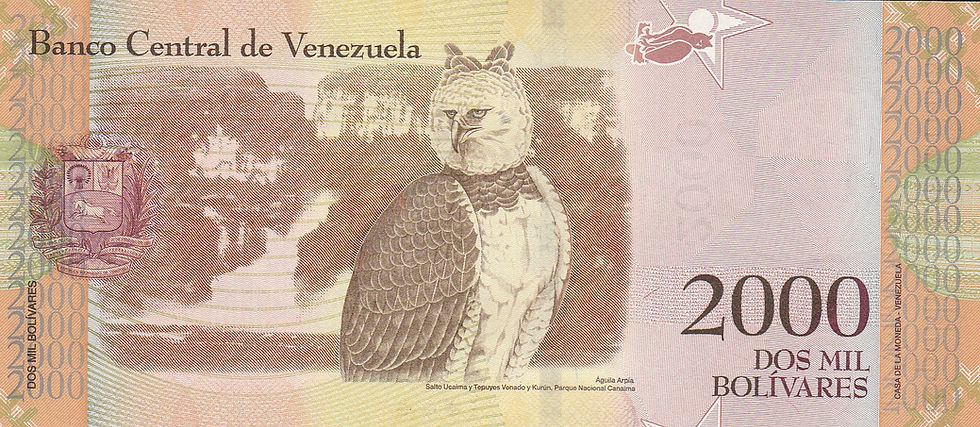Aguilas! The Harpy Eagles of the Canaima 2: 2000 Bolívar Fuerte (Venezuela, 2016)-Article
- smithwicknumismati
- Dec 27, 2020
- 4 min read
Updated: Apr 14, 2024
This Venezuelan banknote represent the 3rd denomination of the Bolívar Fuerte Series (2016). The 2,000 Bolívar Fuerte note (2,000 BsF) was printed August 18, 2016. Making it unusual for having a single known printing run.
Rampant hyperinflation has caused all Bolívar Fuerte denominations to be retired. Including its successor, the Bolívar Soberano (2018). Which currently (2020) has been retired up to it's final denomination, the 500 Bolívar Soberano (500 Bs.F.).
Despite this, retired Venezuelan Bolívar have found a new home. As an easily affordable item for beginning/young collectors. These collectors often become attracted, by the colorful illustrations of Venezuela’s wildlife. Creating decorative displays, with the reverse side out. In honor of that tradition, this note will be reviewed reverse first.
Reverse

The Reverse features a Harpy Eagle, also known as “Aguila Arpía” in Spanish. Harpy eagles are the largest bird of prey in the Amazon rainforest. They are fierce creatures capable of silently flying 80kph (50 mph). They possess the largest talons of any living eagle and been recorded lifting prey equal to their own body weight.
Both male and female harpy eagles sport an iconic double crest. They sexually dimorphic with larger females on average. The average female harpy eagles weighs 6 to 9 kg (13 to 20 lb). While the average male has 35% less mass and weighs 4 to 5.95 kg (8.8 to 13.1 lb). The largest recorded harpy eagle was a captive female named "Jezebel", which weighed 12.3 kg (27 lb).
Harp eagle primary live in the upper canopy of low land rainforests. Preferring to hunt hunt almost entirely from the forest canopy. Although they have been known to occasionally hunt near the forest floor. Or near the forest edge overlooking open semi-open terrain, such as tropical savannahs. Controversially they seemed adaptive to regions with selective logging.
Canaima National Park
The background is an illustration of Ucaima Falls, at Canaima National Park. Located in the Guiana Highlands, Canaima National Park is the second largest park in Venezuela and the sixth largest in the world. It's massive range covers an area the size of Belgium (or Maryland). And is home to the indigenous Permon, who speak a Carib language. The Permon often serve as guides, in this relatively remote park, with its limited dirt roads and airstrips.
Nearly 65% of the park is covered in tepui, which means “house of the gods” in the Permon language. These flat-mountains/mesa dramatically rise from the neighboring jungle and savannas, providing water for the park's iconic waterfalls. The largest tepui, is the heart shaped Auyán Tepui (Devil's House), feeds Angel Falls. The tallest waterfall in the world. Angel Falls is 979 meters (3,212 ft) high, with an uninterrupted fall of 807 meters (2,648 ft), 19x higher than Niagara Falls.
Other popular locations include Autana Tepui which features a cave that runs from one side of the to the other. Roraima Tepui, the park's highest point and reportedly the inspiration for Arthur Conan Doyle's novel The Lost World. And the Laguna de Canaima (Canaima Lagoon), located near the parks namesake Canaima village. Formed by a waterfall cluster, which includes the Ucaima, Golondrina, Wadaima, and Hacha Falls.
Matawi Tepui (place of the dead) and Ptari-Tepui are relatively unexplored and inaccessible. The sear walls of Ptari-Tepui make it highly isolated and its summit is believe to host a number unique plant and animal.

Observe
The vertical observe features Guaicaipuro (1530-1568), the legendary chief of the Teques and Caracas tribes. Guaicaipuro is the most famous and celebrated Venezuelan Caciques (chiefs). He formed a powerful coalition of indigenous tribes, that he led during the Spanish conquest of central Venezuela. Which was motivated by the discovery of gold, on Teques tribal land. Guaicaipuro was assassinated by Spanish conquistadors, in 1568
Countermeasures
Despite the low value of the Bolívar Fuerte, the series utilizes numerous security measures. Both visible and virtually hidden. The Fuerte series alternates between standard and window security strips, throughout it's denominations. This denomination utilizes a gold, windowed security strip. The strip displays jeweled "BCV" in sequence. There is additional vertical holographic strips running between every instance of “BCV”. The "bar" and 3 circles above the (red) serial number, are a denomination designator. Which alternates between the denominations within the series. There is a 2-color light puzzle, below the (black) serial number. Orange(observe) and magenta (reverse) segments merge, when back lit. Highlighting a Harpy Eagle and star.

Micro-Print
The near entirety of the note is covered in alternating lines and micro-print patterns. Where present the micro-text reads “BCV2000”, in sequence. The pattern repeats on all denominations, with the exception of the number (listed denomination). Below the observe's portrait is a native glyph pattern. Overlaid by a large micro-print patterened “BCV”.
Watermark
The watermark features Pedro Camejo, as seen on the note's observe. Below the watermark is an electro-typed text "2000". Unfortunately the color pallet and erratic micro-print lines makes capturing the watermark difficult. Although it can be readily seen, in physical copies of the note.
Ultraviolet Gallery
Bolívar Fuerte Gallery (Observe)
(Gallery features all observe sides of the Bolívar Fuerte)
Bolívar Fuerte Gallery (Reverse)
(Gallery features all reverse sides of the Bolívar Fuerte)
Additional Notes
This note's dimensions are 156 × 69 mm (6.14 x 2.72in), standard for Bolívar Fuerte Series.
On December 8, 2001 Guaicaipuro's remains were symbolically moved to the National Pantheon of Venezuela.
In honor of Chief Guaicaipuro and other native chiefs struggle against Spanish colonialism. October 12 is a national holiday in Venezuela, known as Día de la Resistencia Indígena (Day of Indigenous Resistance).
In 2003, the Venezuelan government enacted Mission Guaicaipuro. A program targeted at restoring the communal land titles and human rights of Venezuela's remaining 33 indigenous tribes.































































Comments